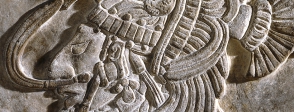
Power and status
Rulers often use monumental building programmes to display their status and reinforce their right to rule. Obvious and more subtle reminders of status are often included within the buildings and associated sculptures. This lintel, which was originally painted in bright colours, is one of a series of three mounted on a building in Yaxchilán, a powerful Maya city. It conveys a direct statement of power by depicting the king, Bird Jaguar IV, large and prominent while a smaller captive kneels in the corner. The king holds a spear suggesting his victorious warrior status, the captive a broken parasol, an object revealing his contrasting fortune as a defeated warrior. The carving of these lintels was in itself an act of power as it was a time- and labour-consuming process: the Maya did not use metal tools, but used stone tools and other natural materials such as string saws.
Bird Jaguar wears the same warrior’s costume as his father on a different lintel, a clearly strategic choice to emphasise his family lineage and legitimate right to rule. The clothing and accessories display power through their quality and the rarity of their materials. His costume may be made of jaguar skin and has shell pieces on the edge which would make a noise as he moved. The tunic over his outfit is also made of shell, his cuffs are jade and his ear and nose plugs could be jade, obsidian, gold or another precious material. In his left hand he carries a cotton ceremonial shield. On his head he wears an elaborate quetzal feather headdress with jade and shell mosaic. The quetzal bird was sacred to the Maya and associated with the god Quetzalcoatl. To kill a quetzal bird was forbidden and punishable with death so the long plume feathers were plucked out individually from living birds. Only royalty or individuals of very high status were allowed to adorn themselves with these feathers.
Bloodletting and sacrifice
A king’s power, and therefore the prosperity of his city state, depended on the favour of the gods. On this lintel the captive has marks of blood on his nose and cheek indicating preparation for a bloodletting ritual. He may also be biting his fingernails in fear. The blood was given to the gods as a renewal of energy and in order to restore blood which, in Mayan creation myths, the gods had given to make humans.
The Maya had numerous festivals and rituals which were marked with sacrifices. However, evidence suggests that the Maya performed far fewer human sacrifices than the Aztecs. Rather, they performed personal blood-letting rites, offering their own blood, and offerings of animal or natural materials such as squirrels, turkeys, pine needles and honey. When human sacrifice was undertaken, for example in rituals for an accession to the throne, the sacrifices were often captives from a nearby city, as is probably the case on this lintel. The ceremony of sacrifice was symbolic of the defeat of the enemy and the victory of the Maya.
More information
Introduction to the lintel
The British Museum’s webpage about the lintel.
https://www.britishmuseum.org/explore/highlights/highlight_objects/aoa/y/yaxchil%C3%A1n_lintel_16.aspx
Other Yaxchilán lintels
A short article about the Yaxchilán lintels with links to other lintels in the British Museum collection.
http://www.britishmuseum.org/explore/highlights/articles/y/the_yaxchil%C3%A1n_lintels.aspx
Another lintel
A lintel that shows an act of personal bloodletting on the British Museum’s website with general information about the Maya and the European discovery of Maya sites.
http://www.britishmuseum.org/explore/highlights/highlight_objects/aoa/y/maya_royal_blood-letting.aspx
A History of the World in 100 Objects
A Maya lintel in A History of the World in 100 Objects from the BBC. Listen to the programme or read the transcript.
http://www.bbc.co.uk/ahistoryoftheworld/objects/SMK6ATSSQbuz6uSNk-fw4w
Who were the Maya?
An educational webpage with information about the Maya.
http://www.mexicolore.co.uk/maya
Maya for children
A resource with a wealth of information about the Maya, designed for a past exhibition at the National Gallery of Art in Washington DC.
http://www.nga.gov/kids/mayakids.pdf
Maya vase image bank
A searchable database of Maya vases with images, useful for looking for specific details.
http://research.mayavase.com/kerrmaya.html
More information
-
Introduction to the lintel
The British Museum’s webpage about the lintel.
Source: britishmuseum.org
-
Other Yaxchilán lintels
A short article about the Yaxchilán lintels with links to other lintels in the British Museum collection.
Source: britishmuseum.org
-
Another lintel
A lintel that shows an act of personal bloodletting on the British Museum’s website with general information about the Maya and the European discovery of Maya sites.
Source: britishmuseum.org
-
A History of the World in 100 Objects
A Maya lintel in A History of the World in 100 Objects from the BBC. Listen to the programme or read the transcript.
Source: bbc.co.uk
-
Who were the Maya?
An educational webpage with information about the Maya.
Source: mexicolore.co.uk
-
Maya for children
A resource with a wealth of information about the Maya, designed for a past exhibition at the National Gallery of Art in Washington DC.
Source: nga.gov
-
Maya vase image bank
A searchable database of Maya vases with images, useful for looking for specific details.
Source: mayavase.com


